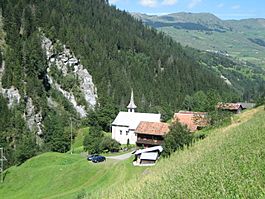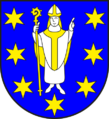St. Martin, Graubünden facts for kids
Quick facts for kids
St. Martin
|
||
|---|---|---|
 |
||
|
||
| Country | Switzerland | |
| Canton | Graubünden | |
| District | Surselva | |
| Area | ||
| • Total | 22.93 km2 (8.85 sq mi) | |
| Elevation | 1,003 m (3,291 ft) | |
| Population
(Dec 2013)
|
||
| • Total | 35 | |
| • Density | 1.526/km2 (3.95/sq mi) | |
| Postal code |
7116
|
|
| Surrounded by | Duvin, Lumbrein, Safien, Suraua, Vals, Vignogn | |
St. Martin (also known as German: Sankt Martin in German and Sogn Martin in Romansh) is a small village in Switzerland. It used to be its own municipality in the Surselva area of the Graubünden canton. On January 1, 2015, St. Martin joined with the nearby municipality of Vals.
Contents
A Look at St. Martin's Past
The village of St. Martin was first settled around the 1300s. People called Walser immigrants came to live here. At first, the village land was like a loan from the Bishop of Chur. This land was managed by the von Tersnaus and von Mont families.
In 1457, German-speaking people from St. Martin faced a rule. They were not allowed to buy land or marry in the next village, Tersnaus. The village church, built in 1345, was first part of a larger church in Vella. But in 1528, it came under the church in Tersnaus. After 1776, St. Martin's church had a German-speaking priest. However, in 1868, it went back under the Tersnaus church.
By 1671, the farms of St. Martin were seen as a part of Tersnaus. Then, in 1878, St. Martin became its own independent municipality. The village stayed very rural, meaning it was mostly farms and nature. In 1972-73, it was the very last municipality in Switzerland to get electricity.
St. Martin's Village Symbol
The official symbol of St. Martin is called a coat of arms. It shows a blue background. On it is Sankt Martin, dressed like a bishop, in silver and gold. He holds a special staff in one hand and raises the other in blessing. Around him are seven golden stars.
Sankt Martin on the symbol represents the village's name. The seven stars stand for the seven small areas, or hamlets, that make up the municipality.
Where is St. Martin?
Before it joined Vals, St. Martin covered about 22.9 square kilometers (8.8 square miles). A good part of this land, about 29%, is used for farming. Forests cover another 32.5%. Only a tiny bit, 0.3%, has buildings or roads. The rest, 38.2%, is made up of rivers, glaciers, or mountains.
The village is located in the Lugnez area of the Surselva district. It's not one big cluster of houses. Instead, it's spread out on the steep slopes above the Valser Rhine canyon. The village sits between 1,000 and 1,700 meters (3,280 and 5,580 feet) high. Most people here speak German. This village marks where the German and Romansh languages meet in the valley.
St. Martin is made up of several small hamlets. These include St. Martin itself, Lunschania (which has the post office), Bucarischuna, Munt, Gadenstatt, Mariaga, and Travisasch. Some other hamlets like Feistenberg, Haspel, and Montaschg are now empty.
People of St. Martin
In 2013, St. Martin had a population of 35 people. All of them were Swiss citizens. Over the past 10 years, the number of people living there has gone down a bit.
Most people in St. Martin speak German. About 86.1% spoke German in 2000. The rest, about 13.9%, spoke Romansh.
In 2000, there were slightly more females (51.2%) than males (48.8%). Looking at ages in 2002:
- 7 children (19.4%) were 0 to 9 years old.
- 4 teenagers (11.1%) were 10 to 19 years old.
- No one was between 20 and 29 years old.
- 6 people (16.7%) were 30 to 39.
- 6 people (16.7%) were 40 to 49.
- 3 people (8.3%) were 50 to 59.
- 3 people (8.3%) were 60 to 69.
- 5 people (13.9%) were 70 to 79.
- 1 person was 80 to 89.
- 1 person was 90 to 99.
In the 2007 election for the Swiss government, the most popular political party was the CVP. It received 67.3% of the votes. Other parties that got votes were the FDP (20%), the SVP (12.7%), and the SP (0%).
About 40% of the adults in St. Martin (aged 25-64) have finished higher education. This means they either went to a special high school or a university.
St. Martin has a very low unemployment rate, meaning almost everyone who wants a job has one. In 2005, 13 people worked in farming and related businesses. There were 7 businesses in this area. Only 1 person worked in manufacturing or construction, with 1 business. No one worked in service jobs like shops or offices.
Here's how the population of St. Martin has changed over time:
| Year | Population |
|---|---|
| 1800 | 139 |
| 1880 | 150 |
| 1900 | 99 |
| 1941 | 83 |
| 1950 | 112 |
| 2000 | 36 |
Images for kids
See also
 In Spanish: Sankt Martin para niños
In Spanish: Sankt Martin para niños







